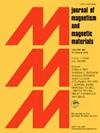预烧结温度对 Sr0.67La0.33Fe11.7Zn0.1Co0.2O19 铁氧体结构、磁性和介电性质的影响
IF 2.5
3区 材料科学
Q3 MATERIALS SCIENCE, MULTIDISCIPLINARY
引用次数: 0
摘要
本研究探讨了不同热处理温度对 Sr0.67La0.33Fe11.7Zn0.1Co0.2O19 铁氧体的磁性能、结构构型和介电特性的影响。M 型铁氧体是用传统的固态方法合成的,热处理温度从 1230 °C 递增到 1310 °C。纯 M 相锶铁氧体是在 1250 ℃ 以上的温度下合成的。理想的预烧结温度为 1270 ℃,在这一温度下,多个因素共同作用,增强了磁性能,包括固态反应的完成和易磁化 c 轴的减弱,这些因素共同促进了超交换相互作用的增强。在此温度下,磁性能达到顶峰,饱和磁化(Ms)为 84.81 emu/g,剩磁(Br)为 419 mT,矫顽力(Hcj)为 3301 Oe。此外,介电常数在低频时明显较高,但随着频率的增加而迅速下降,在 1270 °C 时达到最佳性能。本文章由计算机程序翻译,如有差异,请以英文原文为准。
The influence of pre-sintering temperature on the structural, magnetic, and dielectric properties of Sr0.67La0.33Fe11.7Zn0.1Co0.2O19 ferrite
The present study explores the impact of varying heat treatment temperatures on the magnetic properties, structural configuration and dielectric characteristics of Sr0.67La0.33Fe11.7Zn0.1Co0.2O19 ferrite. M-type ferrite was synthesized using the traditional solid-state method, with thermal treatment temperatures incrementally increasing from 1230 °C to 1310 °C. Pure M-phase strontium ferrite was achieved at temperatures above 1250 °C. The ideal pre-sintering temperature was identified as 1270 °C, where several factors coalesced to enhance the magnetic properties, including the completion of the solid-state reaction and the diminution of the easily magnetized c-axis, which together fostered the intensification of the superexchange interaction. At this temperature, the magnetic properties reached their zenith, with a saturation magnetization (Ms) of 84.81 emu/g, a remanence (Br) of 419 mT, and a coercivity (Hcj) of 3301 Oe. Additionally, the dielectric constant was significantly high at low frequencies but rapidly declined with increasing frequency, achieving its optimal performance at 1270 °C.
求助全文
通过发布文献求助,成功后即可免费获取论文全文。
去求助
来源期刊

Journal of Magnetism and Magnetic Materials
物理-材料科学:综合
CiteScore
5.30
自引率
11.10%
发文量
1149
审稿时长
59 days
期刊介绍:
The Journal of Magnetism and Magnetic Materials provides an important forum for the disclosure and discussion of original contributions covering the whole spectrum of topics, from basic magnetism to the technology and applications of magnetic materials. The journal encourages greater interaction between the basic and applied sub-disciplines of magnetism with comprehensive review articles, in addition to full-length contributions. In addition, other categories of contributions are welcome, including Critical Focused issues, Current Perspectives and Outreach to the General Public.
Main Categories:
Full-length articles:
Technically original research documents that report results of value to the communities that comprise the journal audience. The link between chemical, structural and microstructural properties on the one hand and magnetic properties on the other hand are encouraged.
In addition to general topics covering all areas of magnetism and magnetic materials, the full-length articles also include three sub-sections, focusing on Nanomagnetism, Spintronics and Applications.
The sub-section on Nanomagnetism contains articles on magnetic nanoparticles, nanowires, thin films, 2D materials and other nanoscale magnetic materials and their applications.
The sub-section on Spintronics contains articles on magnetoresistance, magnetoimpedance, magneto-optical phenomena, Micro-Electro-Mechanical Systems (MEMS), and other topics related to spin current control and magneto-transport phenomena. The sub-section on Applications display papers that focus on applications of magnetic materials. The applications need to show a connection to magnetism.
Review articles:
Review articles organize, clarify, and summarize existing major works in the areas covered by the Journal and provide comprehensive citations to the full spectrum of relevant literature.
 求助内容:
求助内容: 应助结果提醒方式:
应助结果提醒方式:


